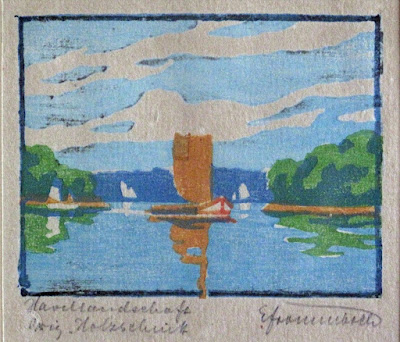Lucien Dasselborne
(Louvroil, North-France 1873 – 1962 Doornik/Tournai
Belgium)
also known as
L. Davril
 |
| The artists studio around 1950 |
Painter and aquatint etcher. Also known as
L. Davril. Started painting during WW1 copying the works and drawings of WW1 and later Congo-Africa painter Fernand Allard L’Olivier (Doornik 1883-1933 Congo) and then moved to Paris for further studying.
 |
| Fernand Allard l'Olivier 1914-1918 |
Lucien exhibited in the 1922 “Salon des Artistes Francais” (“mention honourable”) and in “la Société Nationale” and in 1931 in the
Salon d”Automne. Working in Paris, but belonging to the “Ecole Belgique” he signed
his etchings also L. Davril.
Some of these aquatint etchings are quite lovely but many can be easily confused with the many unartistic and unattractive tourist stuff/wall paper prints that were sold (and bought) by the many thousands 1920-1950.
 |
| Flanders landscape signed L.Davril (this one is nice!) |
When you find a "typical Belgium aquatint
etching" in autum colors showing a historic bridge, canal or building in Brugge or a typical Flanders landscape, the chances
are 90% it is either signed by prolific Belgium etchers Alfred van Neste (1874-1969),
Julien Celos (1884-1953) or Roger
Hebbelinck (b. 1912 but nobody seems to know when he died, did he ?). Van Neste was academically trained in
Antwerp, Hebbelinck and Celos in Brussels.
 |
| Alfred van Neste |
two rather nice Flanders canal prints by Roger Hebbelinck
There are hordes of these prints around (disposed of in house clearings and by grandchildren with Ikea taste),
and although they are mostly irresistibly cheap finds in flea markets asking prices in auction sites like Ebay may suggest otherwise. These prints were very much
to the taste of our grandparents: "old fashioned". But there are positive exceptions !
 |
| "Flanders" signed L. Dasselborne |
These prints (affordable, academical, colorful) adorned
their homes as souvenirs often bought after a Low-lands tourist visit to one
of the very picturesque Belgium medieval cities, Brugge, Gent, Brussels. Often as wedding presents for the new home. Most of them are today considered
gloomy and dull. To be honest: most of them are. Most of them also are deeply browned (burned) because of cheap paper, by acidic mats (passe-partouts) or stained by two generations of happy smoking in small and poorly ventilated rooms ..........
 |
| Le Tour St. Jacques, Paris around 1920, on a rainy summer evening. |
Although Lucien Dasselborne (also d'Asselborne, it is a small village in neighboring Luxembourg where his ancestors will have originated from) was later trained in
Paris, the sparse documentation says he is counted to the “École Belgique” (Belgian School),
probably because of stylish similarities in his Belgium and Flanders landscape etchings compared with those of his
Belgian colleagues.
 |
| Same location around 1900. No automobiles yet. |
But, when in this case it is Paris and the artist, although
he is not very good at drawing people, stages his design with pedestrians,
horse and carriage, an automobile and even a tram and chooses a location that is
rare among Paris artists this was as good a find as it gets on a rainy Sunday car
boot sale near home. A bath removing the browning did it wealth of good.
Lucien Dasselborne choose “la Tour
St. Jacques” seen from Rue de Rivoli on a gloomy evening I think
shortly after WW1, around 1920, when he lived, worked, studied and exhibited in
Paris. The tower and a small park is what is left of 16th century Saint-Jacques-de-la-Boucherie church. It was the starting point of the Paris-Santiago (Compestalla) pilgrimage trail (the "Camino Santiago", 1072 Km, 666Miles). Blaise
Pascal (1623-1662) choose the tower for his scientifique experiments with
air-pressure earning him a statue at its foot.
-------------------
Besides probing into the life of Lucien
Dasselborne this find was also meant to lead me to Fernand Allard l’Ollivier, the painter
who after WW1 explored and travelled and lost his heart in Congo and painted its proud and beautiful people around lake Kivu.
l'Olivier ended tragically drowning after
hitting his head and falling from the ferry in the Congo river near Stanleystad only 50 years old.
Besides the Congo he also had a weak for bathing women and was a keen and humorous draughtsman. His sketches of his adventures in the Congo do taste for more !.
All pictures borrowed freely from the internet for friendly, educational and non commercial use only.

















































